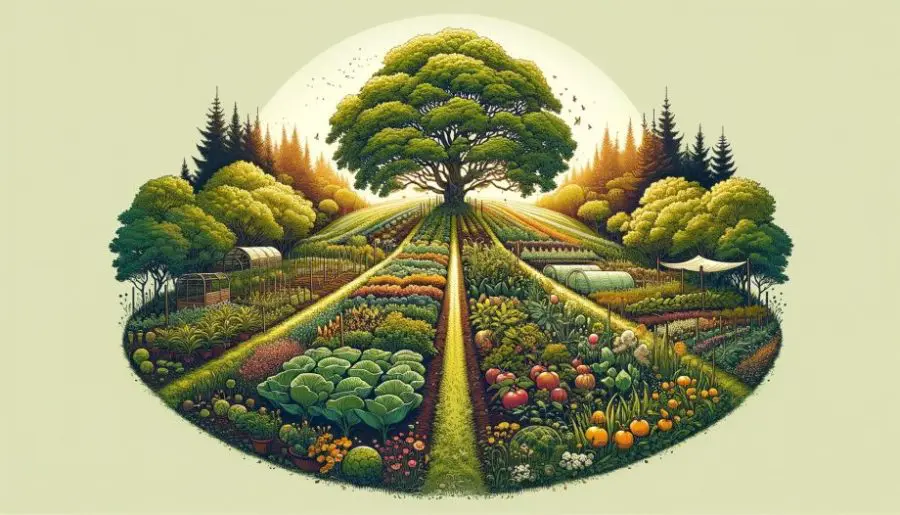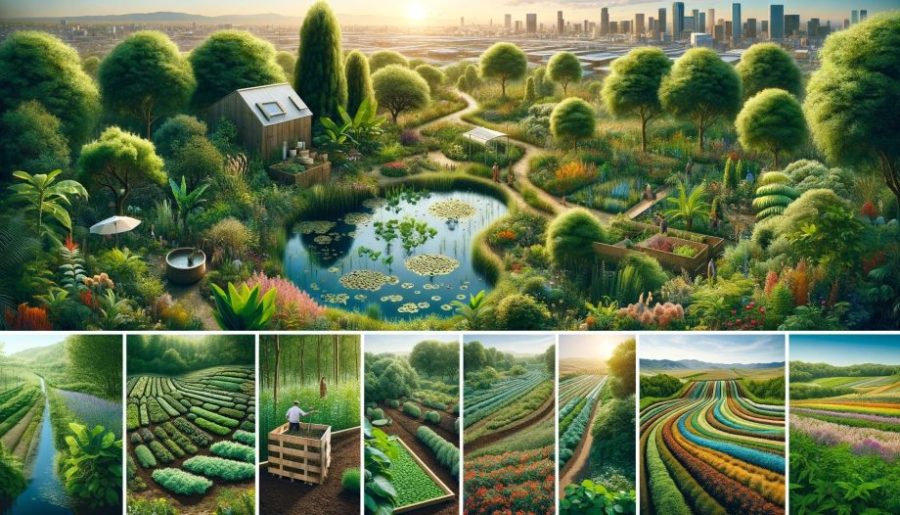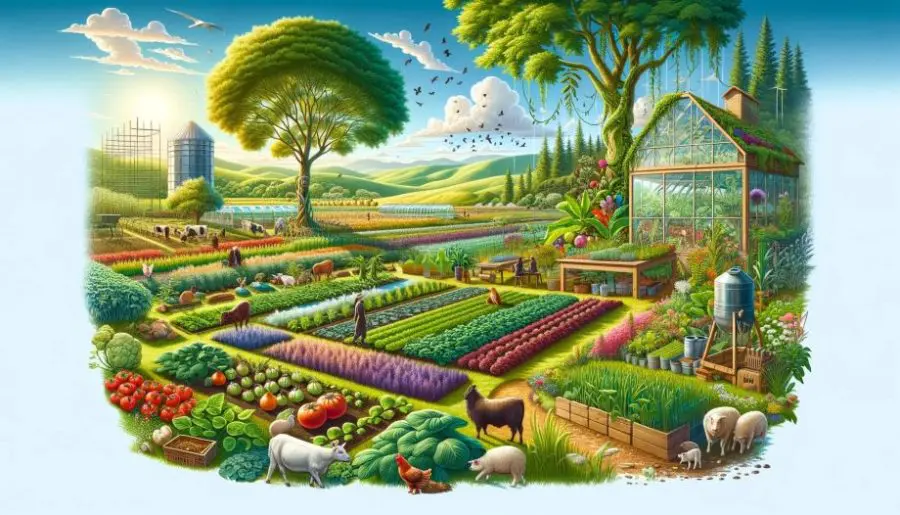
Dive into permaculture vs regenerative agriculture to uncover the secrets and techniques and methods and strategies of sustainable farming. Be taught the best way every enriches our planet in distinctive methods.
Permaculture vs Regenerative Agriculture Key Takeaways:
- Permaculture is a holistic design philosophy for sustainable dwelling, specializing in ecological functions.
- Regenerative agriculture, throughout the meantime, notably targets to rejuvenate soil successfully being and biodiversity by means of farming practices.
- Each contribute uniquely to sustainable ecosystems.
Are you interested in the excellence between permaculture vs regenerative agriculture? You’re throughout the appropriate place!
Be a part of us as we embark on an enthralling journey to unravel these two inexperienced giants of sustainable farming.
We’ll uncover their ideas, advantages, and the easiest way they’re revolutionizing our relationship with the Earth.
Permaculture vs Regenerative Agriculture
All through the search for sustainable farming, two glorious practices have emerged as frontrunners: permaculture and regenerative agriculture.
Whereas each intention to harmonize agriculture with nature, they modify to distinct paths obtain this purpose.
This textual content material delves into these methodologies, unveiling their intricacies and impacts.
We will uncover not merely their definitions and ideas, nonetheless in addition to how they have a look at and distinction with one another and with normal pure farming and regenerative agriculture strategies.
Understanding Permaculture

Permaculture, a time interval coined all through the Nineteen Seventies, intertwines the ideas of permanence, agriculture, and customized.
It’s a design system crafted to create self-sustaining ecosystems that emulate pure environments.
Rooted in ethics like deal with the earth and totally different people, permaculture’s approach is holistic, encompassing not merely meals manufacturing nonetheless a balanced life-style.
Key ideas embody:
- Observing and interacting with nature.
- Catching and storing vitality.
- Guaranteeing range and making use of self-regulation.
Permaculture is an approach to land administration and settlement design that adopts preparations noticed in flourishing pure ecosystems. It encompasses a set of design ideas derived utilizing whole-systems pondering. It applies these ideas in fields akin to regenerative agriculture, metropolis planning, rewilding, and neighborhood resilience. The time interval was coined in 1978 by Invoice Mollison and David Holmgren, who formulated the idea in opposition to modern industrialized strategies, in its place adopting an extra normal or “pure” approach to agriculture. From Wikipedia
Nonetheless permaculture isn’t with out challenges. It requires important knowledge and preliminary funding and may be labor-intensive.
Nevertheless, the payoffs are substantial, with advantages like sustainable ecosystems, decreased waste, and enhanced biodiversity.
Understanding Regenerative Agriculture

What’s regenerative agriculture?
Regenerative agriculture, alternatively, is a holistic farming approach specializing in soil regeneration, biodiversity restoration, and ecosystem successfully being enchancment.
It’s grounded in agroecology, making use of ecological ideas to agricultural functions.
Key practices embody crop rotation, cowl cropping, and decreased tillage, all aiming to rebuild soil successfully being and fertility.
Regenerative agriculture’s advantages are manifold, providing soil restoration, native local weather change mitigation, and sustainable farming.
Nevertheless, transitioning from typical to regenerative agriculture may be robust, demanding modifications in mindset and practices.
Regenerative agriculture is a conservation and rehabilitation approach to meals and farming functions. It focuses on topsoil regeneration, rising biodiversity,[1] bettering the water cycle,[2] enhancing ecosystem corporations, supporting biosequestration,[3] rising resilience to native local weather change, and strengthening the successfully being and vitality of farm soil. From Wikipedia
Permaculture vs Regenerative Agriculture: A Comparative Examine
In our quest for sustainable farming, understanding the nuances between permaculture and regenerative agriculture turns into necessary.
This comparative evaluation delves into these two predominant agricultural practices, uncovering how they align and diverge of their approaches to sustainable farming.
We uncover the broader, holistic nature of permaculture, with its take into account closed vitality cycles and life-style integration, in route of the centered strategy of regenerative agriculture, emphasizing soil successfully being and ecosystem restoration.
This evaluation not solely distinguishes them from normal pure farming nonetheless in addition to highlights how every uniquely contributes to enhancing ecosystem successfully being.
• Shared Targets, Divergent Approaches Whereas permaculture and regenerative agriculture share widespread goals, their approaches and focus areas differ.
• The Broad Scope of Permaculture Permaculture is broader, integrating life-style choices and specializing in making a closed vitality cycle.
• Maintain Soil Correctly being in Regenerative Agriculture Regenerative agriculture, nonetheless, zeroes in on soil successfully being and ecosystem restoration, usually by means of practices like cowl cropping and biodiversity enhancement.
• Earlier Pure Farming: Enhancing Ecosystem Correctly being In distinction with permaculture pure farming and regenerative transcend avoiding artificial chemical substances.
They proactively improve ecosystem successfully being nonetheless with utterly completely totally different focal elements: permaculture in holistic design and regenerative agriculture in soil and biodiversity.
Utility of Permaculture and Regenerative Agriculture in Fairly a couple of Settings


Exploring the flexibleness of permaculture and regenerative agriculture reveals their transformative impression all by way of numerous settings.
This half highlights how these sustainable practices lengthen earlier normal rural farmlands, discovering relevance and adaptableness in metropolis landscapes, yard gardens, and even small neighborhood areas.
We’ll analysis the wide-ranging capabilities of permaculture ideas and the rising recognition of regenerative agriculture’s flexibility all by way of utterly completely totally different local weather conditions and soil sorts.
This exploration underlines the potential of each functions to supply revolutionary decisions to modern agricultural challenges, reshaping our approach to meals manufacturing and ecosystem sustainability.
• Permaculture’s Large-Ranging Adaptability Permaculture’s adaptability is taken under consideration one amongst its strongest property. It’s associated not solely in rural farmlands nonetheless in addition to in metropolis landscapes.
• Metropolis Capabilities of Permaculture From yard gardens to vertical farming in metropolis areas, permaculture ideas uncover their approach into numerous settings, proving that sustainable dwelling is achievable no matter location.
• Contributions to Native Ecosystems This adaptability contributes to native meals manufacturing, neighborhood enchancment, and biodiversity enhancement, even in metropolis environments.
• Regenerative Agriculture: Earlier Rural Boundaries On the choice side, regenerative agriculture, whereas historically linked with rural farming, is more and more extra being acknowledged for its versatility.
• Adapting to Various Environments Its ideas may be tailored to utterly completely totally different local weather conditions and soil sorts, making it a viable choice for a quite a few differ of geographical settings.
• Group Gardens: A Mannequin for Metropolis Regenerative Practices Small-scale implementations, like neighborhood gardens, are showcasing how regenerative practices may be included even in smaller, additional managed environments.
• Potential for World Agricultural Revolution The broad applicability of each functions highlights their potential to revolutionize our approach to agriculture and meals manufacturing, providing viable decisions to the challenges posed by typical farming strategies.
Challenges and Decisions in Implementing Permaculture and Regenerative Agriculture
Adopting permaculture and regenerative agriculture practices holds good promise for a sustainable future, nonetheless it’s not with out its challenges.
This half delves into the sensible difficulties encountered when implementing these strategies.
From the fairly a couple of preliminary funding in permaculture to the paradigm shift required in regenerative agriculture, we uncover the hurdles and the easiest way they’re sometimes overcome.
The first purpose is on the need of training, neighborhood involvement, {{and professional}} steering in navigating these challenges, guaranteeing a worthwhile transition to additional sustainable farming practices.
• Challenges in Implementing Permaculture Regardless of their advantages, implementing permaculture and regenerative agriculture comes with its set of challenges.
• The Preliminary Funding and Experience Required for Permaculture For permaculture, the preliminary funding, each on the subject of time and belongings, may be substantial.
• Overcoming Permaculture Challenges with Training and Group Assist Its labor-intensive nature and the necessity for detailed knowledge and expertise in ecosystem design and administration may be daunting for learners.
• Transitioning Challenges in Regenerative Agriculture Regenerative agriculture faces its non-public set of hurdles. Transitioning from typical to regenerative practices requires a paradigm shift in farming methods and a deep understanding of soil successfully being.
• Assist Methods for Regenerative Agriculture Farmers might have steering in adopting practices like crop rotation, cowl cropping, and integrating livestock.
• Balancing Challenges with Extended-term Advantages In each circumstances, the challenges are outweighed by the long-term advantages these practices present on the subject of environmental sustainability and ecological stability.
Future Traits in Permaculture and Regenerative Agriculture


As we glance ahead, permaculture and regenerative agriculture will not be merely farming practices nonetheless beacons of hope for a sustainable future.
Let’s enhance on the important issue developments shaping their evolution:
Embracing Technological Advances
- Enhancements in Sustainable Farming Methods: Improvement of present units and strategies that improve the effectivity and effectiveness of permaculture and regenerative agriculture.
- Integration of Know-how: Utilization of AI, sensors, and completely totally different tech units to optimize water utilization, monitor soil successfully being, and improve crop range.
World Adoption and Safety Assist
- Rising World Recognition: Extra worldwide locations are recognizing the advantages of those practices and are incorporating them into their agricultural insurance coverage protection insurance coverage insurance policies.
- Authorities and Worldwide Assist: Implementation of insurance coverage protection insurance coverage insurance policies and subsidies to encourage farmers to undertake sustainable practices.
Training and Group Involvement
- Rising Tutorial Initiatives: Introduction of functions and packages at instructional establishments to point sustainable farming ideas.
- Rising Group Engagement: Elevated participation in native permaculture and regenerative agriculture initiatives, fostering a fashion of neighborhood and shared accountability for the setting.
Financial Choices and Market Progress
- Rising Markets for Sustainable Merchandise: Rise in shopper demand for sustainably produced meals, resulting in new market alternate choices.
- Financial Incentives: Monetary advantages for farmers adopting sustainable practices, together with elevated yields and decreased enter prices.
Addressing Native local weather Change and Meals Safety
- Place in Mitigating Native local weather Change: Contribution of those practices to carbon sequestration and low value of greenhouse gasoline emissions.
- Contributions to World Meals Safety: Enhancing the resilience of meals functions in route of native local weather change and completely totally different environmental challenges.
These developments paint a hopeful image of a world the place sustainable farming practices will not be merely house of curiosity nonetheless integral to our agricultural functions.
FAQ: Permaculture and Regenerative Agriculture
Navigating the world of sustainable agriculture can usually result in questions regarding the nuanced variations and capabilities of permaculture and regenerative agriculture.
On this FAQ half, we intention to make clear these ideas, shedding light on their distinctive traits, advantages, and the easiest way they complement one another all through the pursuit of ecological concord.
Whether or not or not or not you’re a seasoned farmer, a gardening fanatic, or simply anybody interested in sustainable practices, these choices will present deeper insights into the transformative potential of permaculture and regenerative agriculture.
Let’s dive into only a few of the largely requested inquiries to demystify these important practices.
Q: What distinguishes permaculture from regenerative agriculture?
A: Permaculture is a holistic approach that integrates agriculture with sustainable dwelling, specializing in designing functions that mimic pure ecosystems.
Regenerative agriculture, nonetheless, notably targets soil restoration and biodiversity enhancement to rejuvenate degraded land and battle native local weather change.
Q: How does permaculture contribute to soil successfully being in regenerative agriculture?
A: In permaculture, practices like composting, crop rotation, and the utilization of pure fertilizers enhance soil constructing and fertility.
These practices furthermore align with regenerative agriculture’s purpose of enhancing soil successfully being and contributing to an extra vibrant and resilient ecosystem.
Q: Can regenerative agriculture ideas be utilized in metropolis settings?
A: Absolutely. Regenerative agriculture may be tailored for metropolis environments by means of metropolis gardens, rooftop farming, and neighborhood composting initiatives.
These practices ship the ideas of soil successfully being and biodiversity to the middle of cities, selling native meals manufacturing and sustainable metropolis dwelling.
Q: What are the financial impacts of adopting regenerative agriculture?
A: Adopting regenerative agriculture could find yourself in long-term financial advantages.
Farmers may even see improved crop yields and decreased want for costly chemical inputs.
Furthermore, additional healthful soils could find yourself in bigger high quality produce, doubtlessly commanding greater market costs.
On an excellent greater scale, these practices contribute to sustainable meals functions, which could be necessary for financial stability and development.
Q: Is permaculture doable for large-scale enterprise farming?
A: Whereas historically related to smaller-scale operations, permaculture’s ideas are scalable.
Large-scale enterprise farms can undertake practices like diversified cropping, environment nice water use, and integration of renewable vitality sources.
The important issue lies in adapting the ideas to swimsuit the dimensions and context of the operation.
Conclusion: Embracing a Sustainable Future by means of Permaculture and Regenerative Agriculture

As we conclude our exploration of permaculture and regenerative agriculture, it’s clear that these practices are additional than merely farming methods; they’re pathways to a sustainable future.
By understanding their ideas, capabilities, and potential impression, we’re going to admire their significance in addressing presently’s environmental challenges.
Let’s encapsulate the important issue takeaways and envision how these practices can sort a greener, additional resilient world.
Key Takeaways and World Affect
- Sustainability and Resilience: Each permaculture and regenerative agriculture present blueprints for sustainable and resilient farming, emphasizing ecological stability and useful helpful useful resource conservation.
- Soil Correctly being and Biodiversity: These practices are pivotal in bettering soil successfully being and selling biodiversity, important components for sturdy ecosystems.
- Native local weather Change Mitigation: Their roles in carbon sequestration and lowering greenhouse emissions place them as necessary gamers all through the battle in route of native local weather change.
- Financial and Social Advantages: Earlier environmental impacts, they provide financial advantages to farmers and communities, fostering native economies and meals safety.
Embracing Change and Overcoming Challenges
- Adapting to New Practices: The transition to those sustainable strategies requires a shift in mindset and farming practices, which could be achieved by means of training and neighborhood help.
- Overcoming Preliminary Limitations: Whereas preliminary investments and modifications may be robust, long-term advantages like improved crop yields and soil successfully being make these practices worthwhile.
Envisioning a Greener Future
- World Adoption and Innovation: The long run lies in wider adoption and regular innovation in sustainable farming practices.
- Group and Safety Involvement: Elevated neighborhood involvement and supportive insurance coverage protection insurance coverage insurance policies are key to mainstreaming these practices.
- Training and Consciousness: Ongoing training and consciousness are important to cultivating a mannequin new interval of farmers and shoppers who prioritize sustainability.
In abstract, permaculture and regenerative agriculture will not be merely decisions to plain farming; they’re important components of a sustainable future.
By embracing these practices, we’re going to create a world the place agriculture works in concord with nature, supporting not merely our present needs nonetheless in addition to these of future generations.









